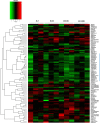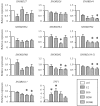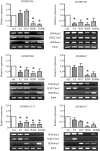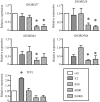Exposure of Human Prostaspheres to Bisphenol A Epigenetically Regulates SNORD Family Noncoding RNAs via Histone Modification
- PMID: 26248216
- PMCID: PMC4606748
- DOI: 10.1210/en.2015-1067
Exposure of Human Prostaspheres to Bisphenol A Epigenetically Regulates SNORD Family Noncoding RNAs via Histone Modification
Abstract
Bisphenol A (BPA) is a ubiquitous endocrine disruptor exerting lifelong effects on gene expression in rodent prostate cancer (PCa) models. Here, we aimed to determine whether epigenetic events mediating the action of BPA on human prostaspheres enriched in epithelial stem-like/progenitor cells is linked to PCa. We performed genome-wide transcriptome and methylome analyses to identify changes in prostaspheres treated with BPA (10 nM, 200 nM, and 1000 nM) or estradiol-17β (E2) (0.1 nM) for 7 days and validated changes in expression, methylation, and histone marks in parallel-treated prostaspheres. BPA/E2-treatment altered expression of 91 genes but not the methylation status of 485,000 CpG sites in BPA/E2-treated prostaspheres. A panel of 26 genes was found repressed in all treatment groups. Fifteen of them were small nucleolar RNAs with C/D motif (SNORDs), which are noncoding, small nucleolar RNAs known to regulate ribosomal RNA assembly and function. Ten of the most down-regulated SNORDs were further studied. All 10 were confirmed repressed by BPA, but only 3 ratified as E2-repressed. SNORD suppression showed no correlation with methylation status changes in CpG sites in gene regulatory regions. Instead, BPA-induced gene silencing was found to associate with altered recruitments of H3K9me3, H3K4me3, and H3K27me3 to 5'-regulatory/exonic sequences of 5 SNORDs. Expression of 4 out of these 5 SNORDs (SNORD59A, SNORD82, SNORD116, and SNORD117) was shown to be reduced in PCa compared with adjacent normal tissue. This study reveals a novel and unique action of BPA in disrupting expression of PCa-associated SNORDs and a putative mechanism for reprogramming the prostasphere epigenome via histone modification.
Figures






Similar articles
-
DNA methylome changes by estradiol benzoate and bisphenol A links early-life environmental exposures to prostate cancer risk.Epigenetics. 2016 Sep;11(9):674-689. doi: 10.1080/15592294.2016.1208891. Epub 2016 Jul 14. Epigenetics. 2016. PMID: 27415467 Free PMC article.
-
Global and region-specific post-transcriptional and post-translational modifications of bisphenol A in human prostate cancer cells.Environ Pollut. 2019 Dec;255(Pt 2):113318. doi: 10.1016/j.envpol.2019.113318. Epub 2019 Oct 2. Environ Pollut. 2019. PMID: 31610501
-
Identification of secretaglobin Scgb2a1 as a target for developmental reprogramming by BPA in the rat prostate.Epigenetics. 2015;10(2):127-34. doi: 10.1080/15592294.2015.1009768. Epigenetics. 2015. PMID: 25612011 Free PMC article.
-
Multigenerational and transgenerational effects of endocrine disrupting chemicals: A role for altered epigenetic regulation?Semin Cell Dev Biol. 2015 Jul;43:66-75. doi: 10.1016/j.semcdb.2015.05.008. Epub 2015 May 28. Semin Cell Dev Biol. 2015. PMID: 26026600 Free PMC article. Review.
-
Epigenetic effects of environmental chemicals bisphenol A and phthalates.Int J Mol Sci. 2012;13(8):10143-10153. doi: 10.3390/ijms130810143. Epub 2012 Aug 15. Int J Mol Sci. 2012. PMID: 22949852 Free PMC article. Review.
Cited by
-
Genomic variants link to hepatitis C racial disparities.Oncotarget. 2017 Aug 1;8(35):59455-59475. doi: 10.18632/oncotarget.19755. eCollection 2017 Aug 29. Oncotarget. 2017. PMID: 28938650 Free PMC article.
-
Low-dose exposure to bisphenols A, F and S of human primary adipocyte impacts coding and non-coding RNA profiles.PLoS One. 2017 Jun 19;12(6):e0179583. doi: 10.1371/journal.pone.0179583. eCollection 2017. PLoS One. 2017. PMID: 28628672 Free PMC article.
-
Unveiling the impact of bisphenol a exposure on gene expression and immune response in diabetic nephropathy through integrative toxicogenomics and molecular dynamics approaches.Diabetol Metab Syndr. 2025 Aug 18;17(1):340. doi: 10.1186/s13098-025-01874-7. Diabetol Metab Syndr. 2025. PMID: 40826470 Free PMC article.
-
Stem Cells as Hormone Targets That Lead to Increased Cancer Susceptibility.Endocrinology. 2015 Oct;156(10):3451-7. doi: 10.1210/en.2015-1357. Epub 2015 Aug 4. Endocrinology. 2015. PMID: 26241068 Free PMC article.
-
EDC-2: The Endocrine Society's Second Scientific Statement on Endocrine-Disrupting Chemicals.Endocr Rev. 2015 Dec;36(6):E1-E150. doi: 10.1210/er.2015-1010. Epub 2015 Nov 6. Endocr Rev. 2015. PMID: 26544531 Free PMC article. Review.
References
-
- Bostwick DG, Burke HB, Djakiew D, et al. Human prostate cancer risk factors. Cancer. 2004;101:2371–2490. - PubMed
-
- Mullins JK, Loeb S. Environmental exposures and prostate cancer. Urol Oncol. 2012;30:216–219. - PubMed
-
- Rubin BS. Bisphenol A: an endocrine disruptor with widespread exposure and multiple effects. J Steroid Biochem Mol Biol. 2011;127:27–34. - PubMed
Publication types
MeSH terms
Substances
Grants and funding
- U01 ES020988/ES/NIEHS NIH HHS/United States
- RC2ES018758/ES/NIEHS NIH HHS/United States
- RC2 ES018789/ES/NIEHS NIH HHS/United States
- CA172220/CA/NCI NIH HHS/United States
- R01 ES015584/ES/NIEHS NIH HHS/United States
- U01ES019480/ES/NIEHS NIH HHS/United States
- P30 ES006096/ES/NIEHS NIH HHS/United States
- RC2 ES018758/ES/NIEHS NIH HHS/United States
- U01ES020988/ES/NIEHS NIH HHS/United States
- P30ES006096/ES/NIEHS NIH HHS/United States
- I01 BX000675/BX/BLRD VA/United States
- R01 CA172220/CA/NCI NIH HHS/United States
- RC2ES018789/ES/NIEHS NIH HHS/United States
- R01ES015584/ES/NIEHS NIH HHS/United States
- U01 ES019480/ES/NIEHS NIH HHS/United States
LinkOut - more resources
Full Text Sources
Other Literature Sources
Molecular Biology Databases

